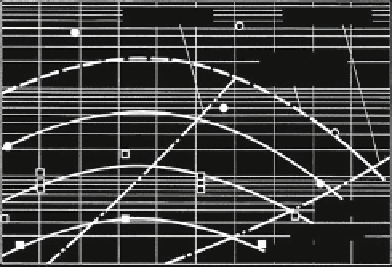Civil Engineering Reference
In-Depth Information
Fig. 2.37 Number of load
cycles N for wire rope C,
Warr. 8 9 19-IWRC-zZ,
resin socket, Feyrer (
1995
)
10
7
S
max
= 0,7 F
o
S
max
= 0,5 F
o
2 S
a
/d
2
= 141 N/mm
2
10
6
10
5
188 N/mm
2
246 N/mm
2
321 N/mm
2
N/mm
2
Lower spec. tensile force S
lower
/d
2
10
4
400
500
0
100
200
300
number of load cycles N up to the wire rope breakage has been found to be, Feyrer
(
1995
)
2
lg
2
S
a
d
e
d
2
S
e
S
lower
d
e
d
2
S
e
S
lower
d
e
d
2
S
e
lg
d
lg N ¼ a
0
þ
a
1
þ
a
2
þ
a
3
þ
a
4
d
e
:
ð
2
:
102
Þ
To make them dimensionless, S
e
= 1 N and d
e
= 1 mm are introduced into the
equation. The other symbols are known already. For using this equation for
practical purposes, the forces are divided by the rope diameter square as so-called
specific forces. The rope diameter d is the nominal rope diameter as used for the
regression calculation. This has the advantage that the deviation of the rope
diameter is included in the standard deviation for the calculated number of load
cycles.
In Table
2.9
, the coefficient of determination B and the standard deviation lg
s for the three stranded ropes A, B and C—calculated with this regression—are
listed as well as the constants a
i
. The great coefficients of determination
B = 0.916-0.941 show that the test results are well expressed with this equation.
Wehking and Klöpfer (1999) found that (
2.102
) was equally valid both for spiral
wire ropes and for Warrington-Seale ropes. For the regression calculation, the
numbers of load cycles N [ 10
6
, or in other cases N [ 1.75 9 10
6
, are not taken
into account as they are considered to be outside the sphere of finite life strength.
In Fig.
2.37
, the lines for the calculated number of load cycles N with (
2.102
)as
well as the test results for the wire rope C are drawn as an example. It is to be seen
that the lines and the test results up to N = 10
6
are close together. The number of
load cycles N increases at first with increasing lower tensile force S
lower
.As
additional information, Fig.
2.37
also includes lines of the upper force with 50 %
(surely the maximum allowed upper force in all cases) and 70 % of the calculated
rope breaking force.


Search WWH ::

Custom Search